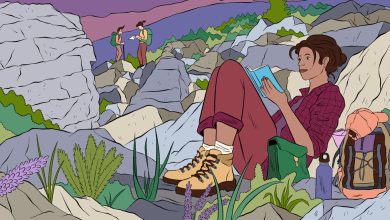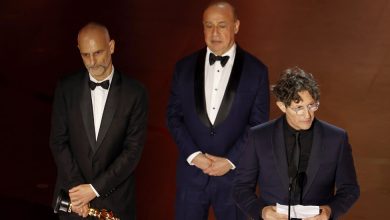Tomás Saraceno: Following the Airborne Lives of Spiders

The Shed has gone all out for the multitasking Tomás Saraceno — a visionary Argentine artist and environmentalist celebrity who ranks among the world’s greatest spider-whisperers — by giving him the run of three of its four public spaces, or about 28,000 square feet. And Saraceno seems to have returned the favor, mounting a revelatory if high-minded survey of his work in makeshift galleries, as well as two inspiring installations elsewhere in the building. The totality is titled “Tomás Saraceno: Particular Matter(s).”
The most ambitious of these is a Shed commission that may leave you feeling, literally, weak in the knees. “Free the Air: How to Hear the Universe in a Spider/Web” is, in essence, the pièce de résistance of this entire undertaking. More later.
The smaller installation, “Museo Aero Solar,” on view in a third large space, centers on an enormous sphere that resembles a tent and is in fact a grounded balloon made of plastic grocery bags — it looks fantastic, like a colorful, translucent crazy quilt and visitors can enter and walk around. It is one of the projects of the Aerocene Foundation, a crowdsourced global group led by Saraceno and dedicated to developing fuel-free flying — powered only by the movements of the wind and sun.
The exhibition and installations together form something like the full Saraceno: part education; part collaboration; part out-of-body experience, with various kinds of beauty threaded throughout. “Particular Matter(s)” is tagged the largest presentation of the artist’s work in the United States. The entirety has been organized by Emma Enderby, the Shed’s curator at large, with Alessandra Gómez and Adeze Wilford, its assistant curators. The Shed display is supplemented in useful ways by Saraceno’s show at his longtime representative, the Tanya Bonakdar Gallery in Chelsea.
Saraceno is not so much an artist as a polymath on a mission and his efforts often seem more like science than art. The Shed’s various displays reflect, to varying degrees, his activities as arachnophile, artist, architect, activist, teacher, musician, environmentalist and social justice warrior for clean air. His overarching goal might be summed up simply as getting humans to live right. This means getting them to understand that they are not the top of a pyramid of power in what is called the Anthropocene era, but exist on a horizontal plane with all non-humans, to which they should be sensitized and from which they have plenty to learn. And they exist in what Saraceno prefers to call the Aerocene era in which interspecies-cooperation and clean air are required.
That said, one might ask how someone with the acute environmental consciousness of Saraceno allows his work to be shown at the Shed. Granted the building, or at least its exterior, may be the best part of the civic catastrophe and failure of will that is Hudson Yards, perhaps the worst of this city’s many recent self-inflicted architectural wounds.
Saraceno’s quest has been inspired by spiders and the ingenious basis of their airborne lifestyle — the multifunctional webs that provide shelter, protection, food and, when vibrated, a means of communication. Spider webs also served as models for levitating sculptures. Consisting of translucent webs and orbs these have become Saraceno’s best-known work, of which “Free the Air” is the latest example.
The exhibition portion of “Tomas Saraceno Particular Matter(s)” begins with the quiet spectacle of his collaborations with spiders: in a darkened gallery, seven plexiglass boxes each holding several different connected webs, all shimmering white. Each web has been built by a different species of spider on a sturdy wire frame in Saraceno’s studio, where he monitors their progress, switching out one species and introducing another as he sees fit. Especially in the dark, these pale, ghostly crystalline structures make you appreciate how much we already owe spiders, since their webs provided early humans with precedents for architecture and textiles.
To the amateur eye, the webs of the different species here generally divide into grids, often in fan-like expanses, pillowy canopies and crazed masses of strands that can resemble tossed pickup sticks suspended in air. The combinations are stunning, suggestive of modern architecture and — because of the abrupt shifts in pattern and rhythm — brush strokes or music. Information about the spiders that worked in each vitrine (how many members of which species for how long) is found, unfortunately, only on a label outside the gallery; it should be available on a handout.
From here, the theme shifts to air pollution, which endangers spiders and humans alike, especially the infinitesimal, breathable grains of carbon called particulate matter. In one nook you’ll see “Arachnomancy,” a deck of tarot cards printed with ink made from particulate matter that pays tribute to the spider diviners of Cameroon.
Occupying three nearby walls, “We Do Not All Breathe the Same Air,” another Shed commission, contends with the inequities of air pollution, which divide along race more than class, according to Harriet A. Washington, author of “Medical Apartheid,” who has written on environmental racism and contributes an essay to the catalog. The works consists of seven large pieces of paper, framed, that measure the pollution at various locations in seven states over two years. The degrees of pollution register in rows of dots ranging from nearly invisible to very dark. They look prettily Minimalist, but illustrate in stark terms this country’s inequities where clean air is concerned.
The show’s last two galleries return to the aesthetics of the webs. “Sounding the Air” consists of five long, thick strands fashioned from multiple silk threads of spider webs. Lights directed at the strands cause them to undulate; via camera and computer, these movements are translated into sounds that resemble avant-garde music. In “How to Entangle the Universe of a Spider/Web?” a laser scans repeatedly through an extended stretch of spider webs. The result is a seemingly cosmic, shifting red gorgeousness. Its message? Spider webs are much more complicated than suggested in show’s opening gallery.
In the final gallery, “A Thermodynamic Imaginary,” Saraceno uses large plexiglass spheres, weblike wires and cords, little glass doodads and their shadows to evoke planetary movement and even an eclipse in a beautiful but dismayingly conventional installation. But a fascinating video playing on this gallery’s left wall lets us glimpse the black aerosolar sculptures, resembling three dimensional kites; they are part of the “Museo Aero Solar” project being tested at Salinas Grandes in Argentina. Watching the sculptures rise up and away from the tiny figures on the ground is a thrilling sight.
If you have been reading the wall texts throughout, you may find this exhibition slightly arduous, but you may have learned an enormous amount and may feel marginally more optimistic about the fate of the planet. It helps to know that respite awaits in the installation pieces, especially the soothing “Free the Air,” Saraceno’s great white sphere (95 feet in diameter) which has more or less eaten the McCourt space. Within are two is a pair of trampoline-like steel webs. The light space darkens, as visitors — seated or prone — listen to, and feel, a 20-minute concert: the vibrations of a composition derived from recorded movements of air particles. It can take you, briefly, out of this world.
The show at Tanya Bonakdar, 521 West 21st Street, is in some ways a continuation of the Shed’s. It centers on the installations made from black polyester rope for which Saraceno first became known. The stretchy ropes crisscross the white space with elaborate spherical structures at their intersections. These resemble stars, snowflakes, magnified particulates and, of course, spider webs — outfitted with live mics connected to active speakers. Visitors are allowed to touch them, setting off vibrations, like spiders in their webs.
The sum of these two exhibitions, but especially the one at the Shed, is a much deeper appreciation of what Saraceno’s love of spiders has set in motion. Whether or not you like these creatures more, they are helping bring about a better future.
Tomás Saraceno: Particular Matter(s)
Through April 17 at the Shed, 545 West 30th Street, Manhattan; 646-455-3494, theshed.org.





